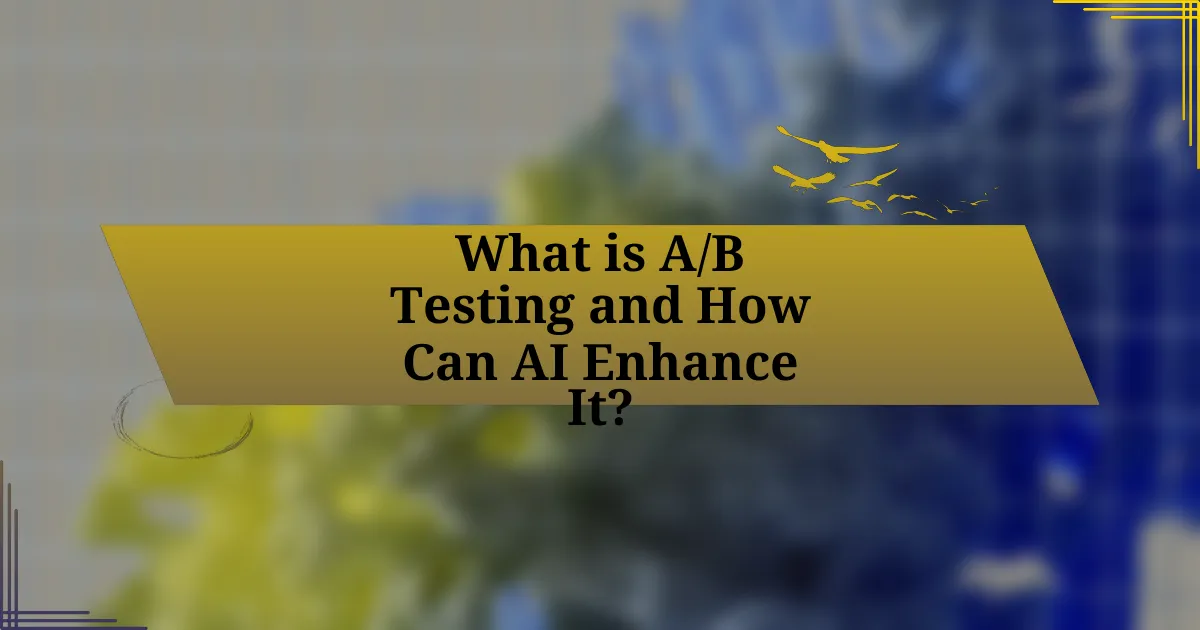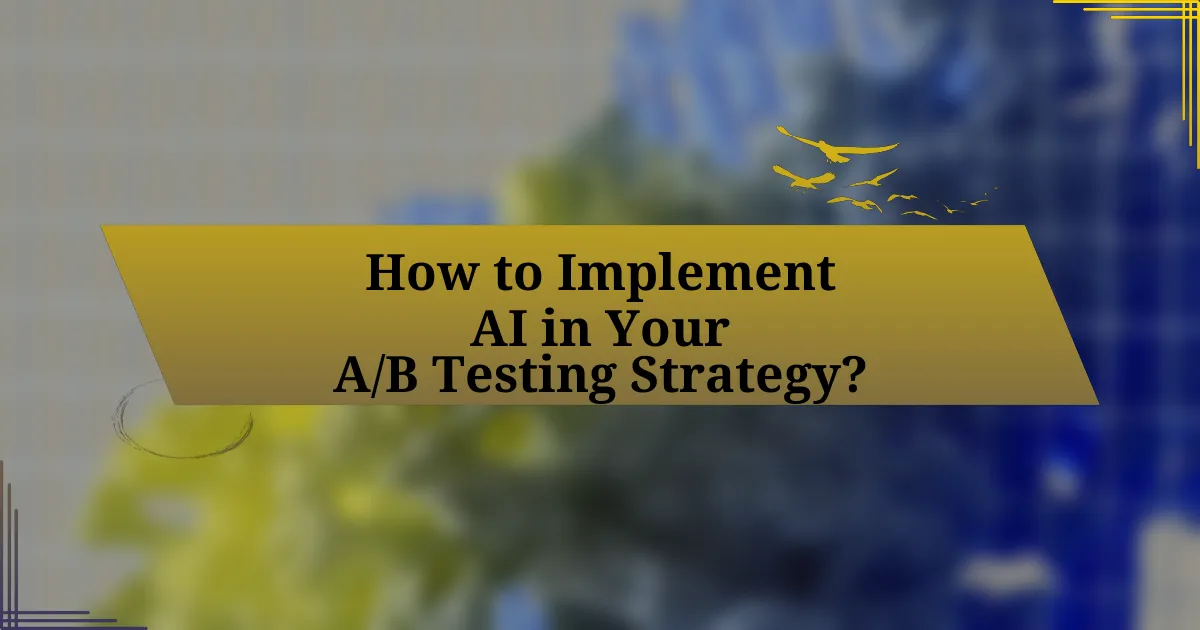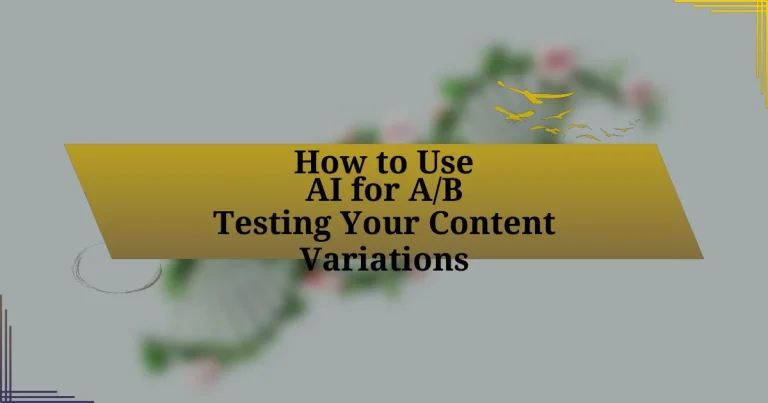The article focuses on the integration of artificial intelligence (AI) in A/B testing for optimizing content variations. It explains the fundamentals of A/B testing, including its key components and how AI enhances the efficiency and accuracy of the testing process. The article outlines the steps for implementing AI in A/B testing strategies, discusses available tools, and highlights best practices for achieving reliable results. Additionally, it addresses common pitfalls to avoid and future trends in AI-driven content optimization, emphasizing the importance of data-driven decision-making in improving conversion rates and user engagement.

What is A/B Testing and How Can AI Enhance It?
A/B testing is a method used to compare two versions of a webpage or product to determine which one performs better in achieving a specific goal, such as increasing conversion rates. AI enhances A/B testing by automating the analysis of large datasets, allowing for faster and more accurate insights into user behavior. For instance, AI algorithms can identify patterns and predict outcomes based on historical data, enabling marketers to make data-driven decisions more efficiently. According to a study by McKinsey, companies that leverage AI in their marketing strategies can see a 10-20% increase in conversion rates, demonstrating the significant impact AI can have on optimizing A/B testing processes.
How does A/B Testing work in content variations?
A/B testing in content variations involves comparing two or more versions of content to determine which one performs better based on specific metrics. In this process, a sample audience is divided into groups, with each group exposed to a different version of the content. The performance of each version is then measured using metrics such as click-through rates, conversion rates, or engagement levels. This method allows marketers to make data-driven decisions by identifying which content variation resonates more effectively with the target audience, ultimately optimizing content for better performance.
What are the key components of A/B Testing?
The key components of A/B Testing are the control group, the variant group, the metric for evaluation, and the sample size. The control group represents the original version of the content, while the variant group contains the modified version. The metric for evaluation is a specific measurement, such as conversion rate or click-through rate, used to assess the performance of each version. Finally, the sample size refers to the number of users included in the test, which must be statistically significant to ensure reliable results. These components work together to determine which version performs better and to make data-driven decisions.
How does AI improve the efficiency of A/B Testing?
AI improves the efficiency of A/B testing by automating data analysis and optimizing test parameters in real-time. Traditional A/B testing often requires manual analysis of results, which can be time-consuming and prone to human error. In contrast, AI algorithms can quickly process large datasets, identify patterns, and predict outcomes, allowing for faster decision-making. For instance, AI can dynamically adjust the variations being tested based on user interactions, ensuring that the most effective options are prioritized. This capability significantly reduces the time needed to reach statistically significant results, enhancing the overall effectiveness of the testing process.
Why is AI important for A/B Testing?
AI is important for A/B testing because it enhances the efficiency and accuracy of the testing process. By leveraging machine learning algorithms, AI can analyze vast amounts of data quickly, identifying patterns and insights that human analysts might overlook. For instance, AI can optimize the selection of variations to test based on user behavior data, leading to more effective experiments. Additionally, AI can predict outcomes and recommend the best-performing variations in real-time, significantly reducing the time needed to reach statistically significant results. This capability is supported by studies showing that AI-driven A/B testing can improve conversion rates by up to 30%, demonstrating its effectiveness in optimizing content variations.
What advantages does AI bring to content optimization?
AI enhances content optimization by enabling data-driven insights and automating the analysis of user engagement. This technology processes vast amounts of data quickly, identifying patterns and preferences that inform content strategies. For instance, AI algorithms can analyze user behavior metrics, such as click-through rates and time spent on pages, to determine which content variations resonate most with audiences. Research from McKinsey indicates that companies using AI for marketing optimization can increase their marketing ROI by 10-20%. This demonstrates the effectiveness of AI in refining content to better meet user needs and improve overall engagement.
How does AI analyze user behavior in A/B Testing?
AI analyzes user behavior in A/B testing by employing machine learning algorithms to evaluate user interactions with different content variations. These algorithms track metrics such as click-through rates, conversion rates, and user engagement levels across the variations. By processing large datasets, AI identifies patterns and preferences, enabling it to determine which version performs better. For instance, a study by Google demonstrated that AI-driven A/B testing can lead to a 20% increase in conversion rates by optimizing user experiences based on real-time data analysis.

How to Implement AI in Your A/B Testing Strategy?
To implement AI in your A/B testing strategy, integrate machine learning algorithms to analyze user behavior and optimize test variations. By utilizing AI, businesses can process large datasets quickly, identifying patterns and predicting outcomes more accurately than traditional methods. For instance, AI can automate the selection of variations based on real-time performance metrics, leading to more efficient testing cycles. Research indicates that companies employing AI-driven A/B testing can achieve up to a 30% increase in conversion rates due to enhanced decision-making capabilities.
What tools are available for AI-driven A/B Testing?
Several tools are available for AI-driven A/B testing, including Google Optimize, Optimizely, and VWO. Google Optimize utilizes machine learning to personalize experiences and optimize conversion rates, while Optimizely offers advanced experimentation capabilities powered by AI to analyze user behavior and improve decision-making. VWO employs AI to automate testing processes and provide insights into user interactions, enhancing the overall testing experience. These tools leverage data analytics and machine learning algorithms to deliver precise results and actionable insights, making them effective for optimizing content variations.
How do these tools integrate with existing content management systems?
These tools integrate with existing content management systems (CMS) through APIs and plugins that facilitate data exchange and functionality enhancement. For instance, many AI-driven A/B testing tools offer direct integration options with popular CMS platforms like WordPress, Drupal, and Joomla, allowing users to implement tests without extensive coding. This integration enables seamless tracking of user interactions and performance metrics, which are essential for optimizing content variations. Additionally, the use of webhooks and SDKs further enhances the ability of these tools to communicate with CMS, ensuring real-time updates and data synchronization.
What features should you look for in A/B Testing tools?
When selecting A/B testing tools, look for features such as user-friendly interfaces, robust analytics capabilities, and integration options with existing platforms. User-friendly interfaces enable marketers to design and implement tests without extensive technical knowledge, while robust analytics capabilities provide insights into user behavior and conversion rates, allowing for data-driven decisions. Integration options with platforms like Google Analytics or CRM systems enhance the tool’s functionality by consolidating data sources, which is essential for comprehensive analysis. These features collectively ensure that A/B testing tools effectively support the optimization of content variations.
How can you set up AI for A/B Testing?
To set up AI for A/B testing, first, select an AI tool that specializes in data analysis and optimization, such as Google Optimize or Optimizely. These tools allow you to create multiple variations of your content and automatically distribute traffic among them. Next, define your key performance indicators (KPIs) to measure the success of each variation, such as conversion rates or user engagement metrics. Implement the AI tool by integrating it with your website or application, ensuring it can track user interactions effectively. Finally, analyze the results using the AI’s built-in analytics features to determine which variation performs best based on the defined KPIs, allowing for data-driven decisions.
What steps are involved in creating content variations?
Creating content variations involves several key steps. First, identify the primary goal of the content, such as increasing engagement or conversion rates. Next, analyze existing content to determine what elements can be varied, such as headlines, images, or calls to action. After that, generate multiple versions of the content based on the identified elements, ensuring each variation is distinct yet aligned with the overall objective. Then, implement an A/B testing framework to distribute the variations to different audience segments. Finally, collect and analyze performance data to determine which variation meets the goal most effectively. This structured approach ensures that content variations are purposeful and data-driven, leading to informed decisions based on measurable outcomes.
How do you define success metrics for your tests?
Success metrics for tests are defined by specific, quantifiable outcomes that align with the goals of the A/B testing process. These metrics typically include conversion rates, engagement levels, and user retention statistics, which provide clear indicators of performance. For instance, a study by Optimizely found that A/B testing can lead to conversion rate improvements of up to 30%, demonstrating the effectiveness of using precise metrics to evaluate test success. By focusing on these measurable outcomes, organizations can make data-driven decisions that enhance their content variations.

What are Best Practices for Using AI in A/B Testing?
Best practices for using AI in A/B testing include defining clear objectives, utilizing robust data analytics, and ensuring proper segmentation of test groups. Clear objectives guide the AI in optimizing variations effectively, while robust data analytics enable the identification of significant patterns and insights. Proper segmentation ensures that the AI can tailor recommendations based on user behavior and demographics, leading to more accurate results. These practices enhance the reliability and effectiveness of A/B testing, as evidenced by studies showing that targeted approaches can increase conversion rates by up to 30%.
How can you ensure accurate results in your A/B Tests?
To ensure accurate results in A/B tests, implement a well-defined testing strategy that includes random assignment of participants, sufficient sample size, and clear metrics for evaluation. Random assignment minimizes bias, ensuring that each variant is tested under similar conditions. A sample size calculator can help determine the necessary number of participants to achieve statistical significance, typically requiring hundreds or thousands of users depending on the expected effect size. Additionally, using specific metrics, such as conversion rates or engagement levels, allows for precise measurement of performance differences between variants. Research indicates that A/B tests with at least 95% statistical significance yield reliable insights, as demonstrated in studies by Kohavi et al. (2017) in “Online Controlled Experiments and A/B Testing.”
What common pitfalls should you avoid when using AI?
Common pitfalls to avoid when using AI include over-reliance on automated outputs, neglecting data quality, and failing to understand the limitations of AI models. Over-reliance on AI can lead to a lack of critical thinking and human oversight, which is essential for interpreting results accurately. Neglecting data quality can result in biased or inaccurate outcomes, as AI systems are heavily dependent on the data they are trained on. Additionally, failing to understand the limitations of AI models can lead to unrealistic expectations and misinterpretation of results, as AI may not always capture the nuances of human behavior or context.
How often should you run A/B Tests for optimal results?
To achieve optimal results, A/B tests should be run continuously and iteratively, ideally on a monthly basis or whenever significant changes are made to the content or user experience. This frequency allows for timely insights and adjustments based on user behavior and preferences. Research indicates that frequent testing can lead to a 20-30% improvement in conversion rates, as it enables businesses to adapt quickly to changing market conditions and user needs.
What are some tips for interpreting AI-driven A/B Testing results?
To effectively interpret AI-driven A/B testing results, focus on statistical significance, which indicates whether the observed differences are likely due to chance. Utilize confidence intervals to understand the range within which the true effect lies, ensuring that the results are not only statistically significant but also practically meaningful. Analyze user segments to identify variations in behavior across different demographics, as AI can provide insights into how different groups respond to changes. Additionally, consider the context of the test, including external factors that may influence results, such as seasonality or market trends. Finally, validate findings with follow-up tests to confirm the reliability of the results, as this helps to mitigate the risk of false positives.
How can you leverage insights from A/B Testing to improve content?
You can leverage insights from A/B Testing to improve content by analyzing user engagement metrics to determine which variations resonate more with the audience. For instance, if one headline leads to a 20% higher click-through rate compared to another, this indicates a stronger appeal and can guide future content creation. Additionally, A/B Testing allows for the identification of specific elements, such as images or calls to action, that enhance user interaction, enabling data-driven decisions that optimize content effectiveness.
What strategies can you use to iterate on your content based on test results?
To iterate on your content based on test results, employ strategies such as analyzing performance metrics, segmenting your audience, and implementing incremental changes. Analyzing performance metrics allows you to identify which content variations resonate best with your audience, as evidenced by data from A/B testing platforms like Optimizely, which report that businesses can increase conversion rates by up to 30% through data-driven decisions. Segmenting your audience helps tailor content to specific demographics, enhancing engagement; for instance, research from HubSpot indicates that personalized content can lead to a 202% increase in conversion rates. Implementing incremental changes ensures that adjustments are manageable and measurable, allowing for continuous improvement based on real-time feedback.
What are the future trends in AI for A/B Testing?
Future trends in AI for A/B testing include the increased use of machine learning algorithms for predictive analytics, enabling more dynamic and personalized testing scenarios. These algorithms can analyze user behavior in real-time, allowing for adaptive experiments that adjust variations based on ongoing results. Additionally, the integration of natural language processing will enhance the ability to analyze qualitative feedback, providing deeper insights into user preferences. Furthermore, automated experimentation platforms are expected to rise, streamlining the A/B testing process and reducing the time required to derive actionable insights. These trends are supported by the growing demand for data-driven decision-making in marketing, as evidenced by a report from McKinsey, which highlights that companies leveraging AI in their marketing strategies can achieve up to 20% higher conversion rates.
How is machine learning evolving in the context of A/B Testing?
Machine learning is evolving in the context of A/B testing by enabling more sophisticated analysis and automation of test designs. Traditional A/B testing often relies on simple statistical methods to compare two variations, but machine learning algorithms can analyze complex patterns in user behavior and predict outcomes more accurately. For instance, techniques such as multi-armed bandit algorithms dynamically allocate traffic to variations based on real-time performance, optimizing results faster than static A/B tests. Additionally, machine learning can segment users based on their characteristics, allowing for personalized testing strategies that enhance user engagement and conversion rates. This evolution is supported by advancements in data processing capabilities and the increasing availability of large datasets, which provide the necessary input for training machine learning models effectively.
What innovations can we expect in AI-driven content optimization?
Innovations in AI-driven content optimization will include advanced algorithms for personalized content delivery, real-time performance analytics, and enhanced natural language processing capabilities. These innovations will allow marketers to tailor content to individual user preferences, analyze engagement metrics instantly, and generate high-quality, contextually relevant text. For instance, AI tools like Google’s BERT and OpenAI’s GPT-3 have already demonstrated significant improvements in understanding user intent and generating coherent content, which enhances the effectiveness of A/B testing by providing insights into what resonates with audiences.
What are practical tips for successful AI A/B Testing?
Practical tips for successful AI A/B testing include clearly defining your objectives, ensuring a sufficient sample size, and utilizing AI algorithms for data analysis. Clearly defined objectives help in measuring the success of variations accurately. A sufficient sample size is crucial as it enhances the reliability of results; studies suggest that larger samples yield more statistically significant outcomes. Utilizing AI algorithms can streamline data analysis, allowing for quicker insights and the ability to identify patterns that may not be immediately apparent through traditional methods.

